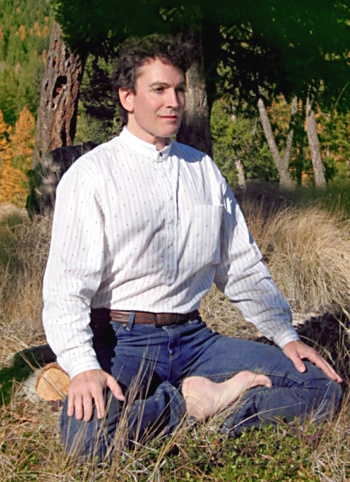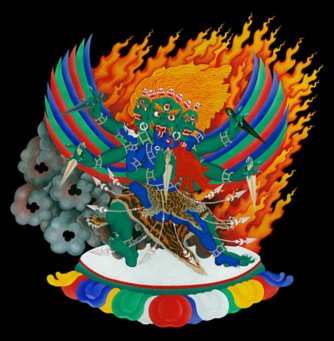
|

|
| home | purpose | practice | meditation... | events... | contact | more about Aro... |
| practices |
|
Living with grace and dignity requires courage, skill, and hard work. An inspiring vision of what is possible for human beings would be no more than an intellectual philosophy – if there were not a way to actualise it in practice. Aro teaches many and varied methods for translating vision into reality. Different practices may be useful to different people, or to one person in different circumstances. Here is a sampling to give a sense of their diversity. 
Silent sitting meditationSilent sitting meditation is the central Aro practice, and the foundation for all other practices. Aro teaches a progressive series of meditation techniques that allow us to perceive the fundamental nature of Mind and reality directly. Here we work with the raw materials of existence: form, emptiness, and non-duality. In meditation, we come face to face with our deepest feelings and conflicts. We may discover aspects of ourselves from which at first we recoil: fear, anger, loss, and shame. However, with further practice we develop a new and relaxed tolerance for the entirety of ourselves and our situations. Habitual emotional patterns lose their grip. Accepting ourselves as we are produces clear self-understanding and appreciative empathy with others. We become transparent to ourselves. Motivation becomes simpler. A cheerful active compassion arises which does not need to be forced or fabricated. Here we find our first real taste of freedom – freedom from conditioning. Meditation gets us back into the driver’s seat – to live life, rather than having life live us. In the open space of clarity and compassion, we find tremendous creative energy, spontaneity, wholeness, and zest for living. There is no point in meditating – other than to discover the exquisite sensual enjoyment of every moment. Learn more about: silent sitting meditation. Flight of the Vulture Fast Padmasambhava mantra Yogic song and Tantric orchestraIn the practices of meditational music, we find the presence of awareness in the dimension of sound. Yogic song and the Tantric orchestra are extensions to silent sitting meditation which intensify experience and shake the structure of habitual thought-patterns. The Flight of the Vulture is a melody whose course emulates the swooping, gliding, and soaring flight of that bird. In Tibet, the vulture is considered a kindly creature and a good omen because it does not kill in order to eat. (Vultures eat only carrion.) The peculiar variations in speed, pitch, and timbre of the song also mimic the dynamics of the thought process, and thereby immobilise it. The Fast Padmasambhava Mantra is employed to rouse energy and combat sleepiness, vagueness, or depression during meditation. The accompanying Tantric orchestra is composed of drums, cymbals, and long trumpets. The dissonant thuds, clangs, and blaats are cacophonous – but they are not music as it is usually understood. When in the midst of an orchestra playing at full volume, conceptuality is overwhelmed: one is thrown directly into a meditative state. Learn more about: yogic song. 
EnvisionmentIn the practice of envisionment, we experience ourselves in the form of a specific enlightened being, called a ‘yidam’. Envisionment is a non-ordinary experience. It is utterly unlike daydreaming, fantasy, or actively ‘imagining ourselves to be enlightened’. Envisionment is only feasible after we have gained significant experience of emptiness – through the practice of silent sitting meditation. We can then ‘disrobe’ ourselves of our accustomed personalities—with their inhibitions—and leap forth; naked of concepts, restricted identities, or personal limitations. In this open dimension, we become no ‘thing’ in particular – yet enabled to grasp the live electrical cables of existence. Thus we experience the pristine voltage of existence that crackles between emptiness and form. We plunge into wisdom-fire and emerge wearing the body of visions – arising vividly as the enlightened yidam. In becoming the yidam, we abandon the narrow confines of what we thought we were. To practice envisionment is to be totally identified with an outrageous expression of the enlightened nature we already possess. We transform our dysfunctional or destructive habitual tendencies into the limitless compassion, energy, and wisdom that are potentially available within everyone. Learn more about: envisionment. 
Dream YogaThe Aro practices of clear light, lucid dreaming, and illusory wakefulness are techniques for finding self-luminous awareness in every moment of the day and night – whatever our state of consciousness is. Both awake and asleep, we lack authentic awareness. During the day, we are distracted by expectations, obligations, and avoidance. In dreams, we lose conceptual consciousness, and in our stupor we are at the mercy of bizarre imaginal events. In deep sleep, we seem to have no awareness at all. The practice of dream yoga allows access to ‘lucid dreaming’ in which we are aware we are dreaming – and thus able to perform ‘miracles’. Choosing to experience anything we can imagine – dreaming becomes a luminous adventure. The practice of clear light allows us to retain awareness through the process of falling asleep and into the deep sleep without dreams. This practice liberates us from addiction to familiar form and enables us to experience pure awareness without sensory or conceptual content. The practice of illusory wakefulness connects powerfully with dream yoga through sitting meditation in waking consciousness, thus revealing the ‘one taste’ or essential sameness of experience in both waking and sleeping. Together, these practices free us from conceptual limitations of time and space – allowing us to experience the simultaneous continuity and discontinuity of experience. We offer weekend retreats on dream yoga. 
Tantric DanceIn Tantric dance, we enact the yidam whom we envision. Tantric dance takes envisionment beyond the meditation cushion into solitary or group performance. In Tantric dance the movements have the felt quality of the energy of the yidam – they portray the enlightened activity of the yidam. In the performance we wear the costume and ornaments of the yidam. The masks or hats we wear, display the visage of the yidam. Tantric dance is meditation in action. It is an opportunity to experience the play of form and emptiness manifesting in the dimensions of motion, sound, and light. |